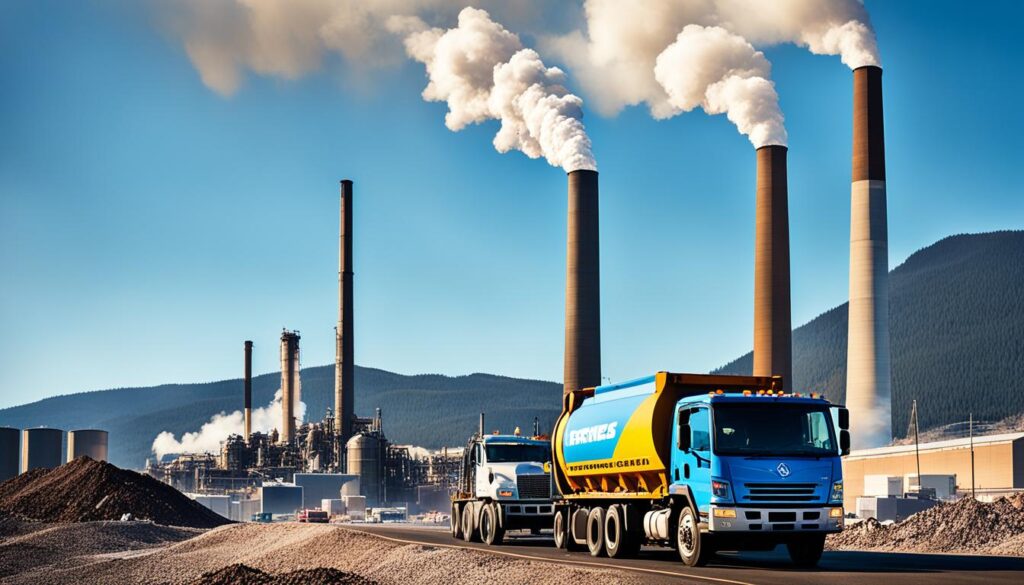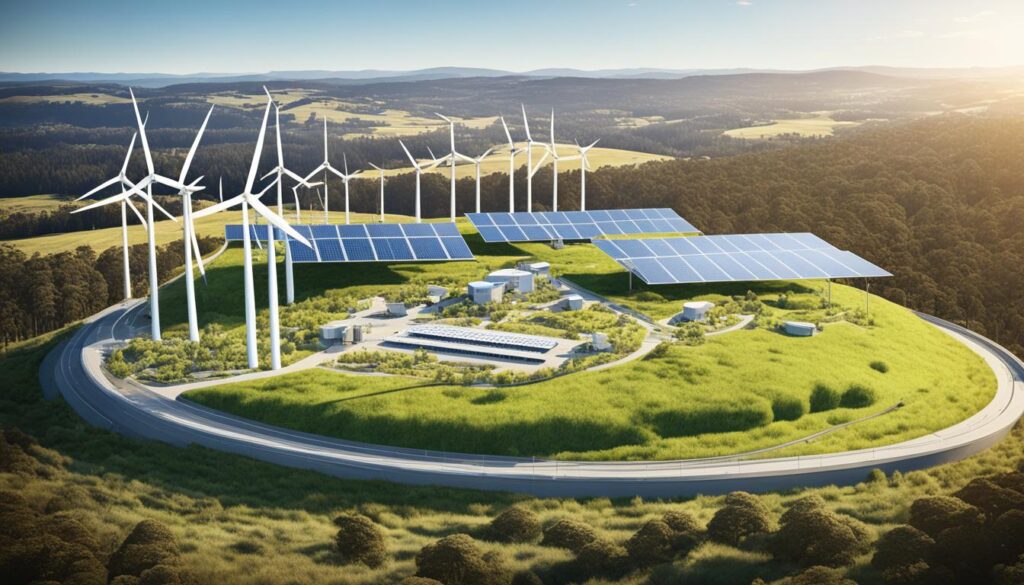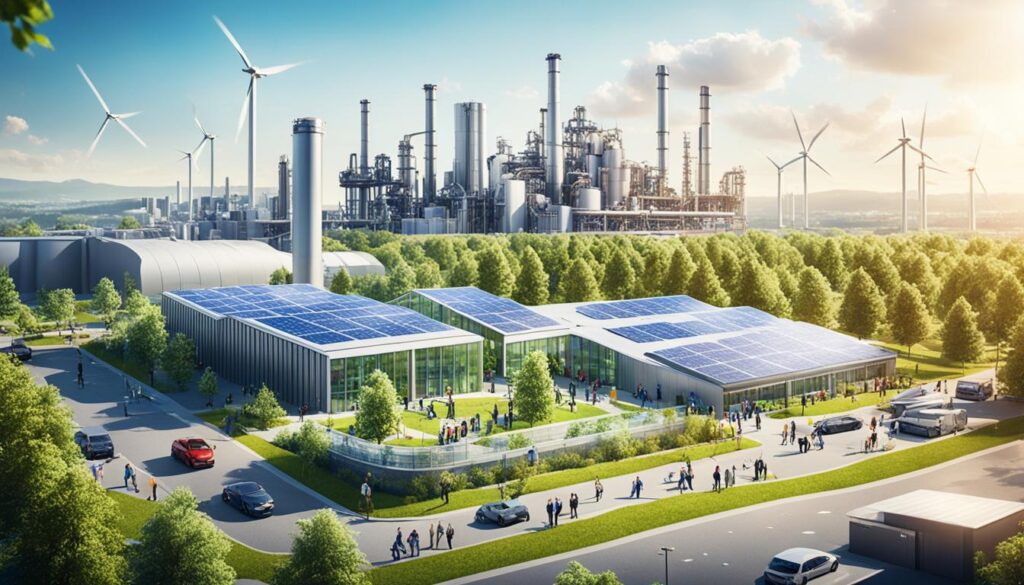When it comes to managing waste, the concept of converting it into energy sounds like a win-win solution. But is it really as sustainable as it claims to be? In Victoria, waste-to-energy projects are on the rise, offering a way to reduce landfill waste and generate renewable energy. However, some critics argue that these projects may have adverse environmental effects. So, are waste-to-energy projects in Victoria truly a green solution or do they pose potential environmental concerns?
Let’s delve into the world of waste-to-energy projects in Victoria to understand their impact on sustainability and the circular economy. We’ll explore the Victorian Waste to Energy Framework, examine ongoing projects, uncover opportunities, and shed light on the government’s waste-to-energy policy. By the end, you’ll have a clearer perspective on whether waste-to-energy is the key to a greener future or a cause for environmental alarm.
Key Takeaways
- Waste-to-energy projects in Victoria aim to generate energy from waste, reducing landfill waste and greenhouse gas emissions.
- The Victorian Waste to Energy Framework sets guidelines for managing waste-to-energy projects and promotes waste avoidance and recycling.
- Various waste-to-energy projects in Victoria, such as biomass generation and anaerobic digestion, contribute to renewable energy production.
- Opportunities in waste-to-energy projects include the production of renewable fuels and the utilization of alternative gases.
- The Victorian Government supports waste-to-energy projects through funding and policy initiatives, striving for a circular economy.
The Victorian Waste to Energy Framework
The Victorian Waste to Energy Framework provides comprehensive guidelines for managing waste to energy projects in Victoria. It recognizes the crucial role waste to energy plays in reducing landfill waste and promoting a transition to a circular economy. With a focus on sustainable industry investment and waste avoidance and recycling, the framework ensures the responsible and efficient management of waste to energy technologies.
Under the Victorian Waste to Energy Framework, there is a cap on the amount of waste that can be heat treated for energy generation. This cap balances the need for industry development with waste reduction goals. The framework supports two broad categories of waste to energy technologies:
- Thermal waste to energy technologies involve processes such as combustion and gasification.
- Biological processing of organic waste, such as anaerobic digestion, is another category supported by the framework.
By promoting these technologies, the framework encourages sustainable innovation and investment in waste to energy projects that have significant environmental and economic potential. It also emphasizes the importance of waste avoidance and recycling, ensuring that waste to energy is integrated into a holistic waste management strategy.
| Advantages of the Victorian Waste to Energy Framework | Disadvantages of the Victorian Waste to Energy Framework |
|---|---|
| 1. Reduces landfill waste. | 1. Potential air pollution from thermal waste to energy processes. |
| 2. Promotes the circular economy. | 2. Limitation on the amount of waste that can be heat treated for energy generation. |
| 3. Supports sustainable industry investment and job creation. | 3. Requires ongoing monitoring and regulation to ensure compliance. |
Waste-to-Energy Projects in Victoria
In Victoria, we are witnessing the implementation of various waste-to-energy projects aimed at harnessing sustainable energy from waste materials. These projects cover a broad spectrum, from reusing forestry residues for biomass generation to establishing anaerobic digestion facilities for processing organic waste. The primary objectives of these projects are to reduce landfill waste, cut costs, and decrease greenhouse gas emissions. As we strive for a greener future, these initiatives align with Victoria’s circular economy goals and the promotion of renewable energy production.
One notable waste-to-energy project in Victoria focuses on converting dairy manufacturing waste into renewable biogas. This innovative approach not only addresses waste management but also creates a valuable resource that can be used for energy generation. Another project aims to establish a bioenergy hub utilizing anaerobic digestion at a medium scale. This hub will contribute to waste reduction while producing clean energy.
These waste-to-energy projects pave the way for a more sustainable future by utilizing waste materials that would otherwise end up in landfills. By generating energy from these resources, we can effectively reduce the strain on traditional energy sources while minimizing environmental impact. These initiatives highlight Victoria’s commitment to renewable energy and the sustainable management of waste.

In addition to their environmental benefits, waste-to-energy projects offer economic advantages, such as job creation and a potential revenue stream from renewable energy production. Victoria’s investment in these projects reflects our determination to foster a thriving bioenergy sector and support sustainable development.
Overall, waste-to-energy projects in Victoria demonstrate our dedication to adopting innovative solutions for waste management and renewable energy generation. By investing in these projects, we can move closer to achieving our sustainability goals, promoting a circular economy, and ensuring a greener and more energy-efficient future for Victoria.
Opportunities in Waste-to-Energy Projects
Waste-to-energy projects in Victoria offer numerous opportunities for sustainable development, contributing to renewable fuel production, waste diversion, and the transition to cleaner energy sources. These projects have the potential to address environmental challenges while promoting economic growth and job creation.
One exciting opportunity lies in the processing of incinerator bottom ash into aggregate for road infrastructure projects. This innovative approach not only reduces the reliance on virgin materials but also provides a valuable outlet for waste that would otherwise end up in landfills.
The Gas Substitution Roadmap further highlights the potential for alternative gases, such as hydrogen and biomethane, to play a significant role in Victoria’s energy future. By substituting conventional fossil fuels with these cleaner alternatives, we can lower greenhouse gas emissions and mitigate climate change.
The Australia Renewable Energy Agency Bioenergy Roadmap outlines the numerous economic and environmental benefits of the bioenergy sector. Waste-to-energy projects can contribute to job creation, reduced emissions, and increased waste diversion from landfills. By harnessing the power of organic waste, such as agricultural residues and food waste, we can generate renewable fuels, such as biodiesel and sustainable aviation fuel, while minimizing waste and its environmental impact.
Example of Waste-to-Energy Opportunities
Table: Opportunities in Waste-to-Energy Projects
| Opportunity | Description |
|---|---|
| Processing of incinerator bottom ash | Convert incinerator bottom ash into aggregate for road infrastructure projects, reducing the need for virgin materials and diverting waste from landfills. |
| Gas substitution | Promote the use of alternative gases like hydrogen and biomethane to replace conventional fossil fuels, reducing greenhouse gas emissions and advancing a greener energy future. |
| Bioenergy production | Utilize organic waste materials, such as agricultural residues and food waste, to produce renewable fuels like biodiesel and sustainable aviation fuel, contributing to waste diversion and reduced emissions. |
By embracing these waste-to-energy opportunities, Victoria can not only tackle waste management challenges but also drive sustainable development, foster a circular economy, and pave the way towards a cleaner and more energy-efficient future.
Victorian Waste-to-Energy Policy
At the forefront of waste management and sustainability, the Victorian Government has developed a comprehensive waste-to-energy policy as part of Recycling Victoria: A New Economy policy. Our aim is to reduce waste, encourage recycling and reuse, and facilitate the transition to a circular economy.
This waste-to-energy policy outlines a 10-year plan for systemic change in waste management, setting the stage for a more sustainable future. As a vital component of the waste hierarchy, waste-to-energy presents a final opportunity for the recovery of materials after waste avoidance, reuse, and recycling.
Embedded within the Recycling Victoria policy, the Victorian Waste-to-Energy Framework governs the sustainable management of waste-to-energy projects. This framework ensures that waste-to-energy technologies adhere to best practices in environmental protection, while also prioritizing waste avoidance and recycling.
One significant feature of the Victorian Waste-to-Energy Framework is the introduction of a cap on the amount of waste that can be heat treated for energy generation. This cap strikes a careful balance between industry investment, waste diversion, and recycling efforts.
We believe that by effectively harnessing waste-to-energy and adhering to the Victorian Waste-to-Energy Framework, we can create a cleaner and more resourceful future for all.
The Cap on Waste-to-Energy Projects
The Victorian Waste-to-Energy Framework sets a clear limit on the amount of waste that can be heat treated for energy generation. This cap ensures a balanced approach, preventing over-reliance on thermal waste-to-energy while encouraging long-term waste avoidance and recycling. Thermal waste-to-energy processes, such as combustion and gasification, are subject to the cap, while specific waste-to-energy technologies and processes are exempt.
“The cap on waste-to-energy projects in Victoria is a significant step towards sustainable waste management and energy generation. By limiting the amount of waste that can be heat treated, we prioritize waste reduction and recycling, fostering a circular economy.” – Victoria Waste Management Authority
Exempt Waste-to-Energy Technologies and Processes
The Victorian Waste-to-Energy Framework allows for the following waste-to-energy technologies and processes outside the cap:
- Advanced Recycling: Innovative recycling technologies that maximize material recovery and waste diversion from landfill.
- Biological Waste-to-Energy Technologies: Processes such as anaerobic digestion that convert organic waste into energy while minimizing greenhouse gas emissions.
- Landfill Gas Collection and Combustion: Utilizing the methane gas produced from landfill sites to generate energy.
- Incineration without Energy Recovery: Safe and controlled incineration of non-hazardous waste that does not involve energy generation.
- Thermal Processes Using Non-Waste Materials: Thermal energy generation from non-waste materials, such as biomass feedstocks or dedicated energy crops.
These exemptions ensure that the cap applies specifically to thermal waste-to-energy processes and encourages the exploration and adoption of sustainable waste management alternatives.
The Benefits of the Waste-to-Energy Cap
Implementing a cap on waste-to-energy projects in Victoria brings numerous benefits:
- Environmental Protection: By limiting thermal waste-to-energy processes, we promote waste reduction, recycling, and the preservation of natural resources.
- Greenhouse Gas Emission Reduction: Encouraging advanced recycling and biological waste-to-energy technologies helps lower methane emissions and mitigate climate change.
- Promotion of Circular Economy: The cap fosters waste avoidance, resource recovery, and the development of sustainable industries in line with the circular economy principles.
- Public Health and Safety: Stricter regulations ensure that waste-to-energy projects adhere to best-practice environment protection standards, safeguarding the well-being of communities.
This waste-to-energy cap, part of the comprehensive Victorian Waste-to-Energy Framework, ensures the responsible and sustainable management of waste while paving the way for a more efficient and eco-friendly future.
Waste Categories for Thermal Waste-to-Energy
Under the proposed waste-to-energy framework, waste is classified into three categories based on its suitability for use as a thermal waste-to-energy feedstock: permitted waste, banned waste, and exempt waste.
Permitted waste can be used for thermal waste-to-energy under a cap license. This category includes waste materials that have been deemed suitable and safe for energy generation while complying with environmental regulations.
Banned waste, on the other hand, cannot be used in any thermal waste-to-energy process. This category includes waste materials that pose significant hazards or have a high potential for environmental harm if used in energy generation.
Exempt waste can be used for thermal waste-to-energy outside of a cap license. This category encompasses waste materials that are considered low-risk in terms of associated environmental impacts and can be used in energy generation without the need for additional regulatory oversight.
The Victorian Waste-to-Energy Framework provides definitions and guidelines for each category, ensuring the proper management and utilization of waste in waste-to-energy projects.
Funding and Support for Waste-to-Energy Projects
The Victorian Government is committed to promoting sustainable waste-to-energy projects in Victoria by providing funding and support. We recognize the importance of investing in innovative technologies that can transform waste materials into valuable energy resources.
To drive progress in this area, the government allocates funding to projects that explore the viability of different waste-to-energy technologies. These include biomass generation, anaerobic digestion, and pyrolysis. By investing in these projects, we aim to develop sustainable and innovative solutions for waste management and energy generation in Victoria.
Our funding supports various aspects of waste-to-energy projects, including:
- Feasibility studies
- Technical research
- Business case development
Through initiatives like Recycling Victoria, we are working towards fostering a circular economy and enhancing resource recovery. Waste-to-energy projects play a pivotal role in achieving these goals by reducing waste sent to landfill and promoting the adoption of green technology.
By supporting waste-to-energy projects, we are not only contributing to the sustainable development of Victoria but also creating opportunities for job growth and economic prosperity.

Conclusion
Waste-to-energy projects in Victoria play a vital role in promoting sustainable development, resource recovery, and the transition to a circular economy. These projects offer opportunities for renewable energy generation, waste diversion from landfill, and reduced greenhouse gas emissions. The Victorian Waste-to-Energy Framework ensures the sustainable management of waste-to-energy projects while focusing on waste avoidance and recycling. With government funding and support, these projects contribute to the growth of the bioenergy sector, job creation, and economic development. By embracing waste-to-energy technologies, Victoria can champion sustainable practices and drive towards a greener and more energy-efficient future.
FAQ
What is waste-to-energy?
Waste-to-energy involves generating energy from waste materials, providing a final opportunity to extract value from material that would otherwise go to landfill.
What is the Victorian Waste to Energy Framework?
The Victorian Waste to Energy Framework sets out the guidelines for managing waste to energy projects in Victoria, recognizing the importance of waste to energy in reducing landfill waste and transitioning to a circular economy.
What types of waste-to-energy technologies are supported by the framework?
The framework supports both thermal waste-to-energy technologies, such as combustion and gasification, and biological processing technologies like anaerobic digestion for organic waste.
What waste-to-energy projects are being undertaken in Victoria?
In Victoria, there are several waste-to-energy projects, including the conversion of dairy manufacturing waste to renewable biogas and the development of anaerobic digestion facilities for organic waste processing.
What are the opportunities in waste-to-energy projects?
Waste-to-energy projects in Victoria present opportunities for processing incinerator bottom ash into aggregate for road infrastructure projects and exploring alternative gases like hydrogen and biomethane for energy generation.
What is the Victorian waste-to-energy policy?
The Victorian waste-to-energy policy, outlined in the Recycling Victoria: A New Economy policy, aims to cut waste, boost recycling and reuse, and promote the transition to a circular economy.
Is there a cap on waste-to-energy projects in Victoria?
Yes, the Victorian Waste-to-Energy Framework establishes a one million tonne per year cap on the amount of waste that can be heat treated for energy generation.
How are waste categories classified for thermal waste-to-energy?
Waste is classified into three categories: permitted waste can be used for thermal waste-to-energy under a cap license, banned waste cannot be used, and exempt waste can be used outside of a cap license.
Is there funding and support available for waste-to-energy projects in Victoria?
Yes, the Victorian Government provides funding and support for various waste-to-energy projects, including feasibility studies, technical research, and business case development.
What are the benefits of waste-to-energy projects in Victoria?
Waste-to-energy projects in Victoria promote sustainable development, resource recovery, and the transition to a circular economy. They contribute to renewable energy generation, waste diversion from landfill, and reduced greenhouse gas emissions.
Source Links
- https://www.vic.gov.au/waste-energy
- https://www.sustainability.vic.gov.au/grants-funding-and-investment/funded-grants/waste-to-energy-fund-bioenergy-funded-projects
- https://www.sustainability.vic.gov.au/grants-funding-and-investment/invest-in-victorias-circular-economy/invest-in-materials-and-infrastructure/invest-in-waste-to-energy
